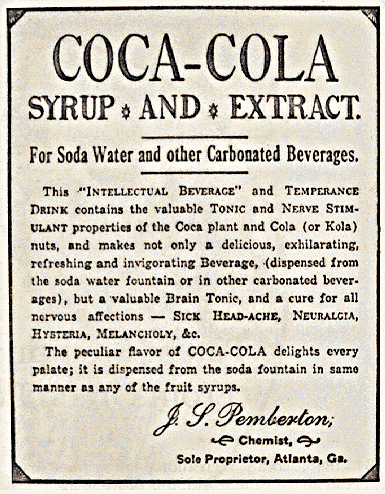
Pemberton Coca-Cola ad
Thursday, December 29, 2005
Page 15
REMINISCING (Column)
Pharmacists Once Touted Soda Pop as Healthful Concoctions
By ROGER M. GRACE
The line which divided soda pops from elixirs was, prior to the 1906 Pure Food and Drug Act, a blurry one.
Drugstores had soda water, and they stocked compounds that were thought to be efficacious in alleviating a variety of maladies. It was inevitable that sugar and flavorings would be added to tonics, thus producing a soda pop that could be touted for its health benefits.
Indeed, early soft drinks that are now major brands were invented by pharmacists. As already recounted here, the nation’s oldest brand of ginger ale was concocted by James Vernor of Detroit, in 1866; Charles Hires developed his root beer at his Philadelphia pharmacy in 1866 or (more likely) later; and Dr. Pepper probably was devised at the Old Corner Drug Store in Waco, Texas, around 1885, whether by the proprietor, Wade Morrison, or his assistant, Charles C. Alderton.
It’s said to have been on May 8, 1886, that druggist John Pemberton’s Coca-Cola was first served at Jacob’s Pharmacy in Atlanta, and some time around 1893 when North Carolina pharmacist Caleb Bradham began selling “Brad’s Drink,” later re-dubbed Pepsi-Cola. Varying dates are given for when the new name went into effect, including Feb. 15, 1896, listed on 1905 and 1937 trademark applications.
Health claims were made for all of these drinks.
•Vernor’s Ginger Ale made a modest claim: that it aided digestion. For example, a soda fountain ad in the Arizona Republican on May 8, 1902 referred to “Vernor’s Ginger Ale for your stomach.” Given the large amounts of ginger extract contained in the beverage then, the claim was no doubt valid.
•Hires Root Beer claims were more elaborate. An ad for Hires Root Beer mix in a Pennsylvania newspaper on June 14, 1877 described the product as a “delicious beverage, possessing properties which will change any morbid action of the stomach, fever and kidneys, and keep them in a healthy condition, promoting strength and vigor.” On the same day, 20 years later, a Hires ad in the Oakland Tribune claimed: “Hires Rootbeer, Carbonated, is a pure, delicious, health-giving temperance drink, that does the children good, refreshes and invigorates the grown folks.”
•Dr. Pepper was touted in the early part of the 20th Century for what it did not contain. An ad in Wichita Falls, Texas on July 12, 1911 labeled it the “pure food beverage,” declaring that it was “absolutely free from caffeine, cocaine, or any injurious drugs.” This was to distinguish it from Coca-Cola which did have added caffeine (then thought by some to be deleterious) and, according to some lab reports, traces of cocaine (though apparently, by 1911, in miniscule and harmless amounts). In later years, Dr. Pepper—which added caffeine in 1917—turned its sugar content into an advertising claim that it provided a pick-me-up at “10-2 and 4 o’clock,” hours when blood sugar level waned.
•Coca-Cola syrup was originally marketed as a stimulant and headache cure. It started out as “Pemberton’s French Wine Coca,” but a temperance law enacted in Atlanta in 1886 forced Pemberton to remove the wine from his recipe. He added sugar, instead. The following year, the pharmacist sold his business, including the Coca-Cola formula, to Willis Venable for $283. Venable added soda water to the syrup, and it became a soft drink—one marketed as “The Ideal Brain Tonic.” Ingredients included “coca” from the coca plant of South America (source of cocaine) and African cola nuts (which contain caffeine). In those early days, the quantum of cocaine was apparently sufficient to produce a noticeable effect. At that time, however, cocaine was a common ingredient in patent medicines, was used by dentists, and was even hailed as a cure for alcoholism. An ad on May 21, 1883 in the Davenport (Iowa) Gazette promoted Burnett’s Cocaine as “the best and cheapest Hair Dressing.” Concern over the safeness of ingesting that substance was just beginning to develop at the end of the century. In the early part of the 20th Century (as future columns will reflect), the manufacturer of Coke had to go to great lengths in asserting the harmlessness of its product.
|
|
Pepsi-Cola in 1903 began billing the beverage as “Exhilarating, Invigorating, Aids Digestion.” In 1907, it adopted the slogan, “The Original Pure Food Drink,” publicizing the lack of any need on its part to modify its formula after passage of the Pure Food and Drug Act. Ingredients were thought to include pepsin, an enzyme which promotes digestion, and cola nuts. The words “Delicious and Healthful” were added to the logo in 1909.
Copyright 2005, Metropolitan News Company